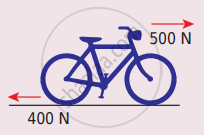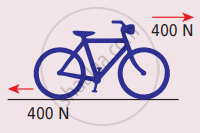Advertisements
Advertisements
Question
Calculate the acceleration of the bicycle of mass 25 kg as shown in Figures 1 and 2.


Solution
Given:
Mass of bicycle m = 25 kg
Fig. I:
Net force acting in the forward direction, F = 500 –
400 = 100 N
acceleration a = `F/m = 100/25` = 4 ms-2
Fig. II:
Net force acting on bicycle F = 400 – 400 = 0
∴ acceleration a = `F/m = 0/25` = 0
APPEARS IN
RELATED QUESTIONS
Choose the correct answer.
At a given instant three-point masses m, 2m and 3m are equidistant from each other. Consider only the gravitational forces between them. Select correct statement/s for this instance only:
Choose the correct answer.
A uniform rod of mass 2m is held horizontal by two sturdy, practically inextensible vertical strings tied at its ends. A boy of mass 3m hangs himself at one-third length of the rod. The ratio of the tension in the string close to the boy to that in the other string is
Choose the correct answer.
Select the wrong statement about the centre of mass:
Choose the correct answer.
For which of the following objects will the center of mass not be at their geometrical center?
(I) An egg
(II) a cylindrical box full of rice
(III) a cubical box containing assorted sweets
A vehicle is moving along the positive x-direction, if a sudden brake is applied, then ______
A stone of mass 2 kg is attached to a string of length 1 meter. The string can withstand a maximum tension of 200 N. What is the maximum speed that stone can have during the whirling motion?
A bomb at rest explodes into 3 parts of the same mass. The momentum of the two parts is `-2"P"hat"i"` and `4"P"hat"J"` respectively. The magnitude of the momentum of the third part is ______
A block of metal w eighing 2 kg is resting on a frictionless plane (as shown in figure). It is struck by a jet releasing water at a rate of lkgs-1 and at a speed of 10 ms-1. Then, the initial acceleration of the block, in ms-2, will be:

A block of mass 40 kg slides over a surface when a mass of 4 kg is suspended through an inextensible massless string passing over a frictionless pulley as shown below. The coefficient of kinetic friction between the surface and block is 0.02. The acceleration of the block is ______.
(Given g = 10 ms-2.)

A steel block of 10 kg rests on a horizontal floor as shown. When three iron cylinders are placed on it as shown, the block and cylinders go down with an acceleration of 0.2 m/s2. The normal reaction R' by the floor if the mass of the iron cylinders is equal and of 20 kg each, is ______.
[take g = 10 m/s2 and µs = 0.2]

